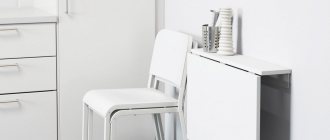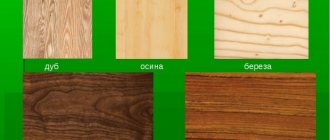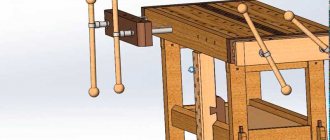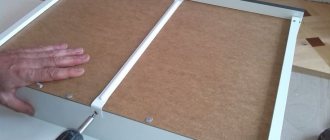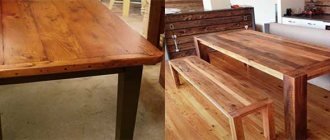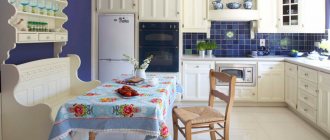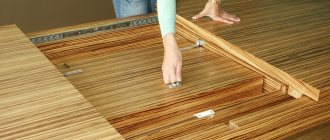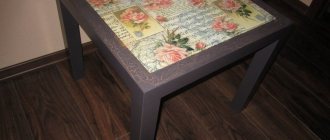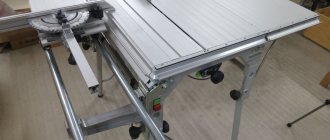Most owners of modern housing note a common problem - lack of free space. In an effort to place all things as compactly as possible, you have to resort to all sorts of tricks. One way to free up space without sacrificing comfort is to make a transforming table with your own hands using a ready-made lifting mechanism. Multifunctional furniture, which has very modest dimensions when folded, can be seamlessly integrated into a wide variety of interiors thanks to a large number of design options. Making a transforming table at home is not difficult; you only need basic craftsmanship skills and correctly cut the components of the structure.
What materials are needed
The choice of materials for the countertop directly depends on what result is expected in the end. For a homemade table, it is important to choose those components that are more affordable. You can choose the following materials for work:
- Tree. The most common option. It should be noted that natural wood is not cheap. The table will have an attractive appearance. The main disadvantage is the large weight of the structure, which will cause difficulties with the installation of the sliding mechanism. A cheaper and more accessible option is to use wooden boards. To ensure reliable fastening, it is necessary to lay them closer to each other. The result will pleasantly surprise you.
Wood is the most successful and popular option, but natural material will be expensive. - Wood shavings. Plywood, MDF, and chipboard are often used. These materials are much cheaper. The main disadvantage is low strength, as well as reduced service life.
Plywood is cheaper than wood, but less durable and strong. - Plastic. Plastic sheets can be selected in a variety of colors. Among the advantages are the affordable cost and ease of assembly of the finished structure.
Plastic sheets are rich in shades, so you can choose the right color for almost any interior. - Glass. Glass countertops have a strong and modern look. At the same time, assembling such a structure at home will be problematic.
Glass countertops are very beautiful, but difficult to assemble yourself.
The choice of one material or another directly depends on the desired result. It is also important to choose a good material for the legs. It is best to make them from wood.
Accessories
The list of components included in the design of folding tables varies depending on the model, but the main parts are the same for all.
- The brackets can be folding or sliding. They are usually made from metal alloys. The bracket is selected depending on the style of the interior and the functional load of the table.
- Base plate for fastening the table top. It can be of different shapes, for example, T-shaped, in the shape of the letter P, in the form of a folding leg. Unlike the bracket, the bar is stationary.
- Loops. Depending on the design, manufacturers use tilt-and-turn options, butterfly hinges or piano furniture hinges to connect the tabletop with other elements.
- Anchor bolts for attaching folding table tops to the wall.
- The console for a folding table can serve as an additional shelf or stand for vases, lamps, boxes, books and other interior elements.
- Fasteners for holding the structure in assembled form, for example, locking hooks for folding tables. Experts advise purchasing folding models with an impact lock. This note is especially relevant for glass tabletops, since if the tabletop is not carefully lowered down, it can hit the wall.
- Roller guides for retractable structural elements or for mobile table models moving along a rail along the wall.
- Decorative details to simplify the transformation process: handles, hinges, levers.
Necessary tools for work
To work you will need to collect a lot of tools. Among them:
- hammer;
- screwdriver;
- Bulgarian;
- machine for grinding work;
- screwdriver;
- hacksaw;
- Bulgarian;
- electric drill;
- paint brush and some others.
To make a transforming table with your own hands, you will need a fairly large set of tools.
A jigsaw is used to process the sheets. To level the surface, you will need a sanding machine. You will also need a compass, tape measure and other measuring instruments to check the quality of the assembly.
Drawings and assembly diagrams of the transformer table
To make a table, you need to create or find a ready-made project. It is necessary to make a general and more detailed drawing, separately for each detail. The classic table layout looks like this:
- The sliding design is significantly different from the usual one.
- The base of the table top is attached to the legs.
- The main part consists of two moving parts.
- The legs are connected to each other by installing a frame. Tabletop parts can move along it.
- To ensure high mobility of tabletop elements, guides are installed. For them, ordinary strips are used, which are used for arranging drawers. The number of additional elements depends on how many parts the countertop has.
After all the parts are fixed, rectangular inserts are folded into the gap. For a simple mechanism for a transforming table with your own hands, this option is sufficient. In more complex versions, lifting mechanisms are installed.
Models
Models are classified according to different parameters.
Depending on the shape
An important criterion when purchasing a folding table is its shape.
- Square ones are optimal for a small family of three.
- The rectangular shape is the most convenient because it is spacious and can be designed for a larger number of people. Depending on the size of the room, such a table can be placed either along the wall or across it.
- The round table is the least popular, but its originality allows it to look great in a classic dining area.
- A semicircular tabletop is more compact than a round one, but is not practical. Therefore, it is often used in loggias and balconies.
Depending on the type of construction
- The mobile folding model differs from the previous one in its mobility. Guides located on the wall allow the tabletop to move along it. A great option for a non-standard layout. As a rule, the structure is equipped with additional leg clamps that provide support and stability in a stationary position.
- Folding bar counter. Often used by designers in modern interiors. It is a long narrow tabletop, the mount of which is built into the wall. The products have an unusual design, for example, glass or mirror inserts make them luxurious. The models are perfect for long kitchens. Since the bar counter is mounted high, it is usually equipped with high stools.
- The suspended version is characterized by the absence of legs. It saves space as much as possible, similar in design to a window sill. Manufacturers produce options with sidewalls.
- A folding table is the simplest option. It differs from a transformer in the absence of additional features. The main difference from all other models is that it does not fold completely to a vertical state, and therefore, when folded, it looks like a cabinet. This design feature is used for storing things.
How to make a mechanism for an extendable table
There are different options for mechanisms. Among them, the most popular options are:
- "Acrobat". An axle with a spring is attached to a metal frame. The tabletop is installed on top. On the sides there are plugs-clamps for the console. Most often this is done on small coffee tables. Sometimes you can find such a mechanism in dining models.
The acrobat mechanism is often found in dining tables. - Sliding. The halves of the table top are attached to a metal mechanism and overlap each other. They slide out along guides.
A sliding mechanism for a transforming table is the simplest option. - Lifting. A simple and compact mechanism that can be easily made at home. To do this, you need to make supports for each half of the sliding structure.
The table lifting mechanism is easy to make yourself.
Note! The mechanism can be made independently. In this case, it is better to give preference to factory options, as they have high strength and reliability compared to other options.
Types of structures
Transformable tables are found in various modifications. There are products for work, eating, reading. Each of these categories has unique characteristics and capabilities. According to their purpose, models are divided into the following types:
- Storage table. It has an unusual design and includes two or three drawers and a table top. This product is opened by rotating along the axis.
- Dinner-magazine. The model is recognized as the most common transforming table. When folded, the product is inconspicuous and does not take up much space. On ordinary days, it is used as a coffee table, and if necessary, the structure can be expanded into a comfortable, full-fledged dining table. With just a few moves, it can comfortably seat 5-7 people.
- Journal worker. This is a transforming table similar to the previous model, for the manufacture of which a different type of tabletop is used. There is no need to completely unfold it or change its shape. This design is used to transform a table into a desk with the ability to adjust the height. There are also additional storage drawers here. In addition, the coffee table top can be repositioned by changing the order of the fasteners.
- Picnic table. The product assumes the presence of two benches, by moving and unfolding which you can get full-fledged comfortable furniture. This model does not contain particularly complex devices; in fact, there is only one mount with a rotating mechanism and a bolt lock.
There is a turntable that has an interesting folding mechanism. Design schemes assume the presence of additional surfaces superimposed on one another. Special metal guides are used here. When unfolded, the top part moves and additional elements appear. Subsequently, all components are combined into a single tabletop.
A transforming rotary table involves the use of inserts responsible for extending additional parts of the tabletop. They come with gas lift or spring. The first insert is distinguished by silent operation, sliding is carried out thanks to internal processing, while the spring operates with little noise. At the same time, the gas lift has its own resource, after which the mechanism weakens and wears out. The spring is recognized as a more durable insert, however, it is also more dangerous, since it can fail and rupture.
Rotary tables are the most popular model. There may be additional parts of the tabletop on the sides. The design of this piece of furniture suggests that all its elements can be transformed. At the same time, there are products that can change height. As a rule, the regulation function is provided for tables with a more complex automatic device.
A fairly common model is a round table. Thanks to its shapes, it helps to “soften” the interior. After unfolding, round products become oval, which significantly increases their size. At the same time, up to 8–10 people can fit behind them. Such a transformer has many advantages: when unfolded, it increases significantly, accommodating many people sitting, and becomes a central, unifying element in the room. At the same time, a round table requires many times more space than similar rectangular structures. The ease of making a round version of transformable furniture yourself is a controversial issue, since cutting out a tabletop for it can only be done with the help of special equipment.
Designers do not recommend placing dark-colored furniture in a small room. Visually, it makes the room even smaller. It is better to give preference to a light table, for example, ivory.
Rectangular transforming tables are no less popular. This model is considered to be a classic option. Among the advantages are spaciousness and compactness. When folded, the product is small in size, and after unfolding it becomes a full-fledged dining table. There are various variations of sliding models; the size during transformation can change slightly or quite significantly. The easiest way to make a rectangular structure yourself is that even a novice craftsman can make such a table.
Journal-worker
Round
Lunch-magazine
Turning
Picnic table
Storage table
How to make a transforming coffee table
To make a good transforming coffee table, just follow a simple algorithm. First you need to select a folding mechanism. After this, a project is created and materials are prepared. Tabletop elements are adjusted to size. Next, the frame and supports are installed. The countertops are installed as a finishing touch.
One of the options for making a transforming coffee table.
It is better to use ready-made drawings or draw them yourself using special computer programs. This will greatly simplify the task of assembling the final structure, and will also help calculate the amount of materials to create the finished product.
Drawing and dimensions for a transforming coffee table.
It is enough to connect the purchased strips with bolts. Assembling the frame will also not be a problem. To assemble all the parts smoothly, it is better to make markings with a pencil in advance.
Transformable coffee tables save space and are quite practical.
What is necessary
Necessary tools for furniture assembly
To successfully assemble the transformer you will need:
- Phillips screwdriver or screwdriver with attachments;
- furniture hammer;
- fasteners and accessories included in the delivery kit.
Detailing the table frame and its legs
Box with fittings and fastenings
Despite the many offers on the furniture market, for most manufacturers the process consists of the following steps:
Housing assembly
Assembling the corner legs of our table
All legs for the transforming table are assembled
Corner legs of two halves are connected with screws or eccentrics. In the same way, a body is assembled from long and short drawers.
Housing assembly diagram
Detailed case assembly process
Screw the legs to the body according to the instructions
IMPORTANT! Special holes are made on the legs and drawers for simultaneous installation of the lift and screed of the entire structure. Check after assembly if they match.
Assembled base with legs
Nail the plastic foot pads to the bottom ends of the legs. At the upper ends of the drawers, install shock absorbers to soften the impact of the tabletop when folding it.
We nail heel pads to the legs
Installation of the lifting mechanism
Installation diagram of the lifting mechanism
Bring the lift into working position. For this:
- hook the spring with one end to the hole inside the lift;
- insert a pin threaded into the second end of the spring into the groove located on the opposite side;
Spring in working order, attached to the mechanism
Fixed springs for operation of the transforming table mechanism
The mechanism is in a calm, unexpanded state
IMPORTANT! The legs of the holders designed for a folding tabletop are higher than those made for the underframe.
Mechanism for bringing the table to the upper position
Installation of countertops and underframes
Mounting a smaller part of the countertop
Installing the base for a large part of the tabletop
Screw the bottom flap of the book-table top and the base to the holder platforms. Install shock absorbers on the outside of the tabletop to absorb shock when unfolding the tabletop. Using an outside-in motion, fold the lift legs into the box. It will be covered by the bottom of the tabletop.
Fix the upper movable part of the tabletop
Place the second half on top so that the end holes for the hidden hinges are on one side, and their center-to-center distance is minimal (about 14 mm). Carefully insert the hinges and secure with screws.
Hidden hinges to secure the table when assembled
The table you assemble will last a long time. Do not forget to tighten its fastening joints once a year, clean the surface with a dry soft cloth or a special furniture polish.
Coffee version or folded table
The process of transforming a table from a coffee table to a table for receiving guests
Dining option or unfolded table
Making a dining table
Creating a transforming dining table is practically no different from the option described above. You can use other, more durable materials. The assembly sequence is the same.
It is better to use more durable materials for the dining table.
A transforming table is a convenient device that allows you to save extra square meters in a small apartment. This furniture will fit perfectly into the kitchen or living room. With this table you can easily accommodate a large number of guests.
What is necessary
Necessary tools for assembling furniture
To successfully assemble the transformer you will need:
- Phillips screwdriver or screwdriver with attachments;
- furniture hammer;
- fasteners and accessories included in the delivery kit.
Detailing the table frame and its legs Box with fittings and fasteners
Despite the many offers on the furniture market, most manufacturers have the process consisting of the following steps:
Housing assembly
Assembling the corner legs of our table All legs for the transformer table are assembled.
Corner legs of two halves are connected with screws or eccentrics. In the same way, a body is assembled from long and short drawers.
Case assembly diagram Detailed process of case assembly Screw the legs to the case according to the instructions
IMPORTANT! Special holes are made on the legs and drawers for simultaneous installation of the lift and screed of the entire structure. Check after assembly if they match.
Assembled base with legs
Nail the plastic foot pads to the bottom ends of the legs. At the upper ends of the drawers, install shock absorbers to soften the impact of the tabletop when folding it.
We nail heel pads to the legs
Installation of the lifting mechanism
Installation diagram of the lifting mechanism
Bring the lift into working position. For this:
- hook the spring with one end to the hole inside the lift;
- insert a pin threaded into the second end of the spring into the groove located on the opposite side;
The spring is in working condition, attached to the mechanism. The springs are fixed for the operation of the mechanism of the transforming table. The mechanism is in a calm, non-folded state.
IMPORTANT! The legs of the holders designed for a folding tabletop are higher than those made for the underframe.
Mechanism for bringing the table to the upper position
Installation of countertops and underframes
We mount the smaller part of the table top. We install the base for the larger part of the table top.
Screw the bottom flap of the book-top table and the underframe to the holder platforms. Install shock absorbers on the outside of the tabletop to absorb shock when unfolding the tabletop. Using an outside-in motion, fold the lift legs into the box. It will be covered by the bottom of the tabletop.
Fix the upper movable part of the tabletop
Place the second half on top so that the end holes for the hidden hinges are on one side, and their center-to-center distance is minimal (about 14 mm). Carefully insert the hinges and secure with screws.
Hidden hinges to secure the table when assembled
The table you assemble will last a long time. Do not forget to tighten its fastening joints once a year, clean the surface with a dry soft cloth or a special furniture polish.
Coffee version or folded table The process of transforming a table from a coffee table into a table for entertaining guests Dining option or folded table
